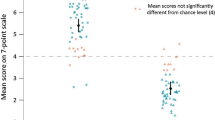Abstract
A content analysis of 32 novels by men and 32 novels by women examined the following aspects of the writer's description of the characters: nonverbal behavior and expression, appearance, personal attributes, and positive and negative emotions. Counts of references in various categories were made, as well as vividness ratings. The ratings were reliable, and the data had an easily interpreted factor structure. Only one variable showed a significant difference between male and female authors: men wrote more vividly about the face than women did There were some historical trends in the description of nonverbal behavior and emotion.
Similar content being viewed by others
References
Argyle, M., Salter, V., Nicolson, H., Williams, M., & Burgess, P. The communication of inferior and superior attitudes by verbal and non-verbal signals.British Journal of Social and Clinical Psychology, 1970,9, 222–231.
Biblowitz, I., et al.Women and literature: An annotated bibliography of women writers (3rd ed.). Cambridge, MA: Women and Literature Collective, 1976.
DePaulo, B.M., Rosenthal, R., Eisenstat, R.A., Rogers, P.L., & Finkelstein, S. Decoding discrepant nonverbal cues.Journal of Personality and Social Psychology, 1978,36, 313–323.
Hall, J.A. Gender, gender roles, and nonverbal communication skills. In R. Rosenthal (Ed.),Skill in nonverbal communication: Individual differences. Cambridge, MA: Oelgeschlager, Gunn & Hain, 1979.
Hiatt, M.The way women write. New York: Teachers College Press, 1977.
Kleck, R.E., & Nuessle, W. Congruence between the indicative and communicative functions of eye contact in interpersonal relations.British Journal of Social and Clinical Psychology, 1968,7, 241–246.
Kramer, C. Perceptions of female and male speech.Language and Speech, 1977,20, 151–161.
Orlofsky, J.L., & Windle, M.T. Sex-role orientation, behavioral adaptability and personal adjustment.Sex Roles, 1978,4, 801–811.
Poyatos, F. Forms and functions of nonverbal communication in the novel: A new perspective of the author-character-reader relationship.Semiotica, 1977,21, 295–337.
Rosenthal, R., & DePaulo, B.M. Sex differences in accommodation. In R. Rosenthal (ed.),Skill in nonverbal communication: Individual differences. Cambridge, MA: Oelgeschlager, Gunn & Hain, 1979.
Sause, E.F. Computer content analysis of sex differences in the language of children.Journal of Psycholinguistic Research, 1976,5, 311–324.
Author information
Authors and Affiliations
Additional information
This study was supported by a Biomedical Research Support Grant from the National Institutes of Health to Johns Hopkins University and by funds from the Department of Psychology and Social Relations, Harvard University. Appreciation is extended to Francine Bilzor for her extensive help in tabulating the data and to Bella DePaulo and Fred Gordon for their helpful comments.
Rights and permissions
About this article
Cite this article
Hall, J.A., Aist, M.B. & Pike, K.M. Nonverbal behavior and person description in men's and women's prose. J Nonverbal Behav 7, 213–222 (1983). https://doi.org/10.1007/BF00986267
Issue Date:
DOI: https://doi.org/10.1007/BF00986267




